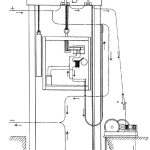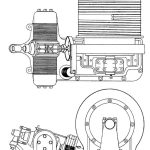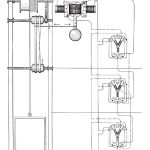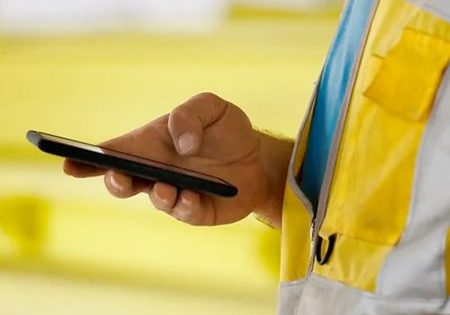The continuation of this industry innovator’s biography focuses on his elevator-industry engineering and attempts at forming electric companies.
In 1904, Thomas Brown, Otis’ chief engineer, claimed that William Baxter, Jr. had designed one of the first electric elevators in 1884 and installed the first direct-connected electric machine in a Baltimore building in 1887.[1] Part one of this biography, which examined Baxter’s career from 1873 to 1888 (ELEVATOR WORLD, June 2019), revealed that no evidence has been discovered that substantiates either of Brown’s claims. However, evidence has been found that supports the idea that Baxter was thinking about electric elevators at this time. On October 11, 1887, the Baltimore Sun reported: “There is now being completed, in this city, an electric motor for elevator purposes, whose owners have invested a large amount of money. . . and feel assured of a satisfactory result.”[2]
The unnamed company was likely Baxter Electric Manufacturing and Motor Co. This supposition is supported by its advertisement in the Baltimore City Directory for 1888, which claimed the company was “now prepared to furnish electric elevators (and) motors for elevators.”[3] It installed the first of several elevator-related applications of Baxter’s electric motors in late 1887 and early 1888. This supports the company’s claim that it could provide “motors for elevators.” These installations involved the electric motor taking over the mechanical role traditionally held by steam engines. Evidence suggesting the company might be able to “furnish electric elevators” first appeared in February 1888 in the U.S. patent record.
The time required to develop an invention to a patentable point varies according to the complexity of the design. And, during the 19th century, the time between filing an application and the issuance of a patent varied from a few months to several years. Thus, the chronology of Baxter’s pursuit of an electric elevator design is best illustrated by his patent application dates (Table 1). The date of his first application, February 28, 1888, suggests that, at some point in the previous year, Baxter had begun to work on designs for electric elevators. This initial application was followed by six more in 1888 (three in March and one each in April, July and September). Baxter’s next two elevator patent applications were filed in December 1890 and January 1891.
Baxter’s first patent, “Overloading and Slack Cable-Stop for Electrical Hoisting Machines,” is intriguing in that it clearly depicts a complete electric elevator, yet the focus of the patent is limited to one discreet operational aspect, a “means for stopping the electric motor automatically” when the car is overloaded or when the movement of the car or counterweight is obstructed.[4] Baxter designed a series of “yielding bearings” that were placed at three points: the pit sheave, one of the small upper sheaves and the large counterweight cable sheave (Figure 1). These were designed to ensure that the sheaves would remain fixed under normal weight or pressure. If the car or counterweight encountered an obstruction, the resulting slack-cable condition would result in decreased pressure on the sheave, which would activate a switch that would switch off power to the motor.
The weight or overload sensor was attached to the car/ cable connection and consisted of a spring that, when compressed, activated an electric circuit that rang a bell, which signaled that the car was overloaded. As was the case with many 19th-century patents, several operational details were omitted from Baxter’s text. Nowhere is this more evident than in his brief description of the elevator’s operation:
“This invention relates to that class of hoisting machines in which an electric motor is used for actuating the hoisting mechanism, and the hoisting car or platform is elevated (by such mechanism) in a vertical or inclined hoistway.”[4]
The failure of Baxter’s first patent to define how the electric motor was used “for actuating the hoisting mechanism” was corrected in his second application, “Electric Hoisting Machine.” This patent concerned “an electrical hoisting-machine arranged to transmit the motion of the motor-armature to a hoisting drum or wheel by screw or worm gearing,” with the motor designed “to operate with a constant current.”[5] The elevator described in this patent appears to be similar to the system Thomas Brown claimed Baxter had invented in 1884. The discrepancy in the dates and Brown’s memory is intriguing. Baxter’s design, in many ways, did set a precedent that later machines followed. Its only unique feature was an inclined worm gear. Baxter thought that the angled “trough” would keep the gear effectively “immersed” in oil and that it would “sustain the thrust of the screw” (Figure 2).[5]
Baxter’s third patent application, dated March 8, 1888, presents a slight mystery. The patent concerned a design for “an electric hoisting- machine. . . in which a single metallic bed performs the double function of sustaining the various elements in their proper relation to one another, while it also serves as a bridge in magnetic connection with the cores of the field- magnet, so as to form a neutral part of the motor-magnet field.”[5] He referred to this application in the “Electric Hoisting Machine” patent (referencing its serial number); however, no patent with a corresponding serial number was issued. The evidence suggests that Baxter may have, for unknown reasons, withdrawn the application and that he continued to work on this problem until late 1890. His patent filed in December 1890 for an “Electric Elevator” addressed the following issue:
“The proximity to the motor of heavy iron pieces, as the drum, gearing, and frame or bed, tends to greatly disturb the action of the magnetic field upon the armature of the motor. To obviate this defect and secure the greatest electrical efficiency in a motor thus situated, I connect the iron supporting frame or bed of the machine magnetically with the field and also arrange the hoisting-drum and intermediate gearing in magnetic connection with the bed so as to form a neutral part of the field.”[6]
This description closely parallels the earlier application in the design of the motor bed. The patent illustrations also depict a machine similar in design to that described in his second patent (Figure 3).
The next two patents concerned car and landing operating switches. The first patent addressed a variety of operations and safety features:
- A switch that would stop the car if “a door or gate opposite a car-landing” was opened
- A landing indicator that showed if the car was moving
- “Magnetic locking devices” designed to ensure that “landing- doors would be held closed until the car reached the landing”
- Stop switches designed “to stop the car at the opposite ends of its course or travel.”[7]
Baxter also included a system for use on residential elevators:
“In private dwellings where an attendant is not employed to operate the elevator, the car would be actuated chiefly by means of the landing-switches, and I provide an indicator or bell to be actuated by a branch circuit to show before the landing-switch is operated whether the car is already in motion.”[7]
The second patent focused solely on landing-switch operation.
This system was designed to:
“. . .control the movements of a car or platform carrying no operator It is, therefore, provided with means for indicating to an operator at any one of the series of switches whether any other switch in the series has been turned from its normal position, the indicator showing if the car or platform is already in motion.” [8]
The last two applications filed in 1888 concerned improvements to the systems addressed in Baxter’s earlier patents. His final patent application, filed in January 1891, applied his electric switch designs to belt-driven systems (Figure 4):
“By my invention, I am enabled to dispense with the pull-ropes that have always heretofore been used to actuate a coupling-shifter and am enabled to connect a hoisting-pulley with a continuously rotating shaft by any suitable coupling device and actuate such coupling device by the mere movement of an electric switch. Such means of actuating the coupling device is far more convenient and durable than a pull-rope.”[9]
With this final patent, Baxter completed an investigation that embraced a new elevator typology — the direct-connected electric machine — and he attempted to bridge the gap between older belt-driven systems and modern electrical operating systems.
Baxter’s efforts effectively set the stage for Baxter Electric Manufacturing and Motor “to furnish electric elevators” to waiting customers. However, no evidence has been uncovered thus far that confirms that any Baxter electric elevators were manufactured. This lack of production may have been tied to the company’s business fortunes. In September 1888, it opened a new factory with a lavish public ceremony that garnered a lengthy article in the Baltimore Sun.[10] Three months later, the Washington D.C Evening Star reported that the company had failed, due to its “inability to make prompt collections.”[11]
Although it was believed to have sufficient funds to pay existing debts, by September 1889, the company was in receivership, and an auction was scheduled to sell the company’s assets. However, the auction was postponed, and, by December, an effort to reorganize the business was underway. This work was successfully concluded in January 1890, and Baxter Electric Motor Co. was established. Baxter was hired in May as the chief electrician, and the company’s focus shifted from elevators to electric railways. However, by December 1893, the company was once again in financial trouble. It was declared insolvent in October 1894, and its assets were sold at auction in May 1895.
At this low point in his career, Baxter had not pursued any elevator- related work for almost four years. And, following the company’s closure, he abandoned this work, as well as all other electric motor-related pursuits. The conclusion to this biography will trace the final phase of Baxter’s career, which included significant contributions as a technical writer, new engineering projects and pursuits, and his return to elevator technology and elevator design.
| Patent Title | Application Date | Patent Date | Patent Number |
| Overloading and Slack Cable-Stop for Electrical Hoisting Machines | February 28, 1888 | December 25, 1888 | 394,952 |
| Electric Hoisting Machine | March 2, 1888 | April 7, 1891 | 446,661 |
| title unknown (application withdrawn) | March 8, 1888 | N/A | N/A |
| System of Operating Electric Elevators | March 17, 1888 | March 31, 1891 | 449,611 |
| System of Operating Electric Elevators With Landing Switches Only | April 20, 1888 | April 7, 1891 | 449,662 |
| Electric Elevator | July 19, 1888 | August 23, 1892 | 481,386 |
| Electric Elevator | September 3, 1888 | January 12, 1892 | 466, 973 |
| Electric Elevator | December 8, 1890 | December 1, 1891 | 464,470 |
| Electric Controller for Elevators | January 29, 1891 | November 24, 1891 | 463,615 |
- Figure 1: “Electric elevator” from William Baxter, Jr.’s December 25, 1888, patent “Overloading and Slack Cable-Stop for Electrical Hoisting Machines”
- Figure 2: “Direct connected electric elevator” from Baxter’s April 7, 1891, patent “Electric Hoisting Machine”
- Figure 3: “Direct connected electric elevator” from Baxter’s December 1, 1891, patent “Electric Elevator”
- Figure 4: “Belt driven elevator controlled by electric switches” from Baxter’s November 24, 1891, patent “Electric Controller for Elevators”
References
[1] Thomas E. Brown. “Passenger Elevators,” Transactions of the American Society of Civil Engineers, Vol. 23 (1904).
[2] “Elevators in Private Houses,” Baltimore Sun (October 11, 1887).
[3] R.L. Polk & Co.’s Baltimore City Directory for 1888, Baltimore: Nichols, Killam & Maffitt (1888).
[4] William Baxter, Jr. “Overloading and Slack Cable-Stop for Electrical Hoisting Machines,” U.S. Patent No. 394,952 (December 25, 1888).
[5] William Baxter, Jr. “Electric Hoisting Machine,” U.S. Patent No. 446,661 (April 7, 1891).
[6] William Baxter, Jr. “Electric Elevator,” U.S. Patent No. 464,470 (December 1, 1891).
[7] William Baxter, Jr., “System of Operating Electric Elevators,” U.S. Patent No. 449,611 (March 31, 1891).
[8] William Baxter, Jr. “System of Operating Electric Elevators with Landing Switches Only,” U.S. Patent No. 449,662 (April 7, 1891).
[9] William Baxter, Jr. “Electric Controller for Elevators,” U.S. Patent No. 463,615 (November 24, 1891).
[10] “The Baxter Works Opened,” Baltimore Sun (September 20, 1888).
[11] “The Baxter Company Fails,” Washington D.C Evening Star (December 5, 1888).
Get more of Elevator World. Sign up for our free e-newsletter.













